Environmental Efficiency Evaluation in the Top Asian Economies: An Application of DEA
Abstract
1. Introduction
1.1. Why ASIA?
1.2. “Green Growth” Measurements
2. Literature Review
2.1. Data Envelopment Analysis (DEA) Method
2.2. The Environmental Efficiency Index (EEI)
3. Materials and Methods
3.1. Research Process
3.1.1. Part 1: Literature Review
3.1.2. Part 2: Data Collection
3.1.3. Part 3: Data Analysis Is Divided into Three Basic Steps
- -
- Step 1: Reviewing DEA models to choose the Undesirable outputs model and DEA-Solver software in dealing with the problem of bad outputs and measuring the efficiency of DMUs (Appendix A).
- -
- Step 2: The Pearson coefficient is implemented to the isotonic data. This step needs to be re-performed until the correlation closing to +1; it means that the input and output variables have a positive relationship.
- -
- Step 3: Data of 20 DMUs are estimated by DEA, and the results are analyzed in two directions: efficiency classification and overall rating. The authors will estimate the average value of environmental efficiency indicator (EEI) and classified into four groups, namely “Excellent” with 0.99 < EEI < 1, “Good” with 0.8 < EEI < 0.9, “Average” with 0.5 < EEI < 0.79, and “Improvable” with 0 < EEI < 0.49.
3.1.4. Part 4: Analysis and Discussion
3.2. Reliable Data Sources
3.3. Data Collection
3.3.1. Inputs Selection
3.3.2. Outputs Selection
3.4. Undesirable Outputs Model
4. Results
4.1. Statistical Description
4.2. Pearson Correlations
4.3. Performance Ranking—Undesirable Outputs Model
4.3.1. Undesirable Output Model Analysis
4.3.2. Classification of Efficiency
- “Excellent environmental efficiency” includes the countries with an average efficiency between 0.99 and 1.00.
- “Good environmental efficiency” includes the countries with an average efficiency between 0.80 and 0.98.
- “Average environmental efficiency” includes the countries with an average efficiency between 0.50 and 0.79.
- “Improvable environmental efficiency” includes the countries with an average efficiency between 0.00 and 0.49.
- Two countries are in the category of “Excellent environmental efficiency”, namely Hong Kong and Bangladesh, that is represented by the green color in Table 6.
- Two countries are in the category of “Good environmental efficiency”, namely Japan and Taiwan, that is represented by the yellow color in Table 6.
- Two countries are in the category of “Average environmental efficiency”, namely Israel and Singapore, that is represented by the orange color in Table 6.
- Fourteen countries are in the category of “Improvable environmental efficiency”, namely Philippines, United Arab Emirates, Qatar, South Korea, Indonesia, Iraq, Saudi Arabia, Vietnam, Pakistan, China, Thailand, India, Malaysia, and Iran, and they are represented by the red color in Table 6.
5. Discussion
5.1. Comparison between the Average EEI and the Inputs
5.2. Comparison between the Average EEI and the Outputs
5.3. Improving Methods of All Countries
6. Conclusions
Author Contributions
Funding
Institutional Review Board Statement
Informed Consent Statement
Acknowledgments
Conflicts of Interest
Appendix A
| Authors | Sample Characteristics | Method | ||
|---|---|---|---|---|
| Unit/Time Period | Inputs | Outputs | ||
| Hu and Kao (2007) [39] | 17 APEC economies: 1991–2000 | (1) Energy consumption (2) Labor (3) Capital | GDP | DEA CRS |
| Zhou and Ang (2008) [40] | 21 OECD countries: 1997–2001 | (1) Labor (2) Capital (3) Coal consumption (4) Oil consumption (5) Gas consumption (6) Other energy consumption | (1) GDP (2) CO2 emission | Environmental CRS DEA |
| Gielen and Taylor (2009) [41] | Indian industrial sectors | Energy consumption | GDP | IEA energy efficiency index based on BAT/BPT |
| Zhang et al.(2011) [42] | 23 developing countries: 1980–2005 | (1) Labor (2) Capital (3) Energy consumption | GDP | VRS DEA |
| Xie et al. (2014) [43] | Electric power Industries in 26 OECD and BRIC countries | (1) Labor (2) Installed capacity (3) Fuel consumption (4) Nuclear energy consumption | (1) Electric power (2) CO2 | SBM-DEA |
| Moutinho et al. (2018) [44] | 16 Latin America countries | (1) Labor (2) Capital (3) Weight of fossil energy (4) Share of renewable energy in GDP | (1) GDP (2) Greenhouse gases | DEA Window |
| Wang et al. (2021) [45] | 42 potential countries in renewable energy |
(1) Population (2) Total energy consumption (3) Total renewable energy capacity |
(1) GDP (2) Total energy production | DEA Window and Fuzzy TOPSIS model |
References
- Song, M.; An, Q.; Zhang, W.; Wang, Z.; Wu, J. Environmental efficiency evaluation based on data envelopment analysis: A review. Renew. Sustain. Energy Rev. 2012, 16, 4465–4469. [Google Scholar] [CrossRef]
- Zhu, W.; Xu, L.; Tang, L.; Xiang, X. Eco-efficiency of the Western Taiwan Straits Economic Zone: An evaluation based on a novel eco-efficiency model and empirical analysis of influencing factors. J. Clean. Prod. 2019, 234, 638–652. [Google Scholar] [CrossRef]
- Mathew, M.J.; Sautter, B.; Ariffin, E.H.; Menier, D.; Ramkumar, M.; Siddiqui, N.A.; Delanoe, H.; del Estal, N.; Traoré, K.; Gensac, E. Total vulnerability of the littoral zone to climate change-driven natural hazards in north Brittany, France. Sci. Total Environ. 2020, 706, 135963. [Google Scholar] [CrossRef] [PubMed]
- Conrad, E.; Cassar, L.F. Decoupling Economic Growth and Environmental Degradation: Reviewing Progress to Date in the Small Island State of Malta. Sustainability 2014, 6, 6729–6750. [Google Scholar] [CrossRef]
- Linda, C. The International Energy Outlook; Energy Information Administration: Washington, DC, USA, 2020. [Google Scholar]
- EU. A Healthy and Sustainable Environment for Generations to Come; European Union: Brussels, Belgium, 2014. [Google Scholar]
- Seiford, L.M.; Thrall, R.M. Recent developments in DEA: The mathematical programming approach to frontier analysis. J. Econ. 1990, 46, 7–38. [Google Scholar] [CrossRef]
- Rogge, N.; De Jaeger, S. Evaluating the efficiency of municipalities in collecting and processing municipal solid waste: A shared input DEA-model. Waste Manag. 2012, 32, 1968–1978. [Google Scholar] [CrossRef]
- Tsai, W.H.; Lee, H.L.; Yang, C.H.; Huang, C.C. Input-Output Analysis for Sustainability by Using DEA Method: A Comparison Study between European and Asian Countries. Sustainability 2016, 8, 1230. [Google Scholar] [CrossRef]
- Hermoso-Orzáez, M.J.; García-Alguacil, M.; Terrados-Cepeda, J.; Brito, P. Measurement of environmental efficiency in the countries of the European Union with the enhanced data envelopment analysis method (DEA) during the period 2005–2012. Environ. Sci. Pollut. Res. 2020, 27, 15691–15715. [Google Scholar] [CrossRef]
- Wang, K.; Yu, S.; Zhang, W. China’s regional energy and environmental efficiency: A DEA window analysis based dynamic evaluation. Math. Comput. Model. 2013, 58, 1117–1127. [Google Scholar] [CrossRef]
- Li, K.; Lin, B. Metafroniter energy efficiency with CO 2 emissions and its convergence analysis for China. Energy Econ. 2015, 48, 230–241. [Google Scholar] [CrossRef]
- Xu, T.; You, J.; Li, H.; Shao, L. Energy Efficiency Evaluation Based on Data Envelopment Analysis: A Literature Review. Energies 2020, 13, 3548. [Google Scholar] [CrossRef]
- Farrell, M.J. The Measurement of Productive Efficiency. J. R. Stat. Soc. Ser. A (General) 1957, 120, 253–290. [Google Scholar] [CrossRef]
- Wang, C.-N.; Nguyen, X.-T.; Wang, Y.-H. Automobile Industry Strategic Alliance Partner Selection: The Application of a Hybrid DEA and Grey Theory Model. Sustainability 2016, 8, 173. [Google Scholar] [CrossRef]
- Pereira de Souza, M.V.; Diallo, M.; Castro Souza, R.; Baidya, T.K.N. The Cost Efficiency of the Brazilian Electricity Distribution Utilities: A Comparison of Bayesian SFA and DEA Models. Math. Probl. Eng. 2010, 30. [Google Scholar] [CrossRef]
- Nguyen, P.; Nguyen, N.T. Using optimization algorithms of DEA and Grey system theory in strategic partner selection: An empirical study in Vietnam steel industry. Cogent Bus. Manag. 2020, 7, 1832810. [Google Scholar] [CrossRef]
- Zhou, X.; Wang, Y.; Chai, J.; Wang, L.; Wang, S.; Lev, B. Sustainable supply chain evaluation: A dynamic double frontier network DEA model with interval type-2 fuzzy data. Inf. Sci. 2019, 504, 394–421. [Google Scholar] [CrossRef]
- Cook, W.D.; Seiford, L.M. Data envelopment analysis (DEA)—Thirty years on. Eur. J. Oper. Res. 2009, 192, 1–17. [Google Scholar] [CrossRef]
- Goto, M.; Otsuka, A.; Sueyoshi, T. DEA (data envelopment analysis) assessment of operational and environmental efficiencies on Japanese regional industries. Energy 2014, 66, 535–549. [Google Scholar] [CrossRef]
- Tyteca, D. Linear programming models for the measurement of environmental performance of firms-concepts and empirical results. J. Prod. Anal. 1997, 8, 183–197. [Google Scholar] [CrossRef]
- Golany, B.; Roll, Y. An application procedure for DEA. Omega 1989, 17, 237–250. [Google Scholar] [CrossRef]
- Tone, K. A slack-based measure of efficiency in data envelopment analysis. Eur. J. Oper. Res. 2001, 130, 498–509. [Google Scholar] [CrossRef]
- Feng, C.; Wang, M. Analysis of energy efficiency and energy savings potential in China’s provincial industrial sectors. J. Clean. Prod. 2017, 164, 1531–1541. [Google Scholar] [CrossRef]
- Cooper, W.W.; Seiford, L.M.; Tone, K. Introduction to Data Envelopment Analysis and Its Uses: With DEA-Solver Software and References; Springer Science and Business Media: Berlin, Germany, 2006. [Google Scholar]
- Wu, X.; Tan, L.; Guo, J.; Wang, Y.; Liu, H.; Zhu, W. A study of allocative efficiency of PM2.5 emission rights based on a zero sum gains data envelopment model. J. Clean. Prod. 2016, 113, 1024–1031. [Google Scholar] [CrossRef]
- Hu, J.-L.; Wang, S.-C. Total-factor energy efficiency of regions in China. Energy Policy 2006, 34, 3206–3217. [Google Scholar] [CrossRef]
- Wang, C.-N.; Le, A.L.; Hou, C.-C. Applying Undesirable Output Model to Security Evaluation of Taiwan. Mathematics 2019, 7, 1023. [Google Scholar] [CrossRef]
- Halkos, G.; Petrou, K.N. Assessing 28 EU member states’ environmental efficiency in national waste generation with DEA. J. Clean. Prod. 2019, 208, 509–521. [Google Scholar] [CrossRef]
- Lee, P.; Park, Y.-J. Eco-Efficiency Evaluation Considering Environmental Stringency. Sustainability 2017, 9, 661. [Google Scholar] [CrossRef]
- Yu, S.-H.; Gao, Y.; Shiue, Y.-C. A Comprehensive Evaluation of Sustainable Development Ability and Pathway for Major Cities in China. Sustainability 2017, 9, 1483. [Google Scholar] [CrossRef]
- Wang, C.N.; Tibo, H.; Duong, D.H. Renewable Energy Utilization Analysis of Highly and Newly Industrialized Countries Using an Undesirable Output Model. Energies 2020, 13, 2629. [Google Scholar] [CrossRef]
- Yvon-Durocher, G.; Allen, A.P.; Bastviken, D.; Conrad, R.; Gudasz, C.; St-Pierre, A.; Thanh-Duc, N.; Del Giorgio, P.A. Methane fluxes show consistent temperature dependence across microbial to ecosystem scales. Nat. Cell Biol. 2014, 507, 488–491. [Google Scholar] [CrossRef] [PubMed]
- Haro, K.; Ouarma, I.; Nana, B.; Bere, A.; Tubreoumya, G.C.; Kam, S.Z.; Laville, P.; Loubet, B.; Koulidiati, J. Assessment of CH4 and CO2 surface emissions from Polesgo’s landfill (Ouagadougou, Burkina Faso) based on static chamber method. Adv. Clim. Chang. Res. 2019, 10, 181–191. [Google Scholar] [CrossRef]
- OECD. Towards Green Growth in Southeast Asia; OECD Green Growth Studies; OECD Publishing: Paris, France, 2014. [Google Scholar]
- Sherman, H.D.; Zhu, J. Service Productivity Management, Improving Service Performance Using Data Envelopment Analysis (DEA); Chapter 2: Data Envelopment Analysis Explained; Springer Science & Business Media: Berlin, Germany, 2006. [Google Scholar]
- Charnes, A.; Cooper, W.W.; Rhodes, E. Measuring the efficiency of decisión making units. Eur. J. Oper. Res. 1978, 2, 429–444. [Google Scholar] [CrossRef]
- Ichimura, M.; Nam, S.; Bonjour, S.; Rankine, H.; Carisma, B.; Qiu, Y.; Khrueachotikul, R. Eco-Efficiency Indicators: Measuring Resource-Use Efficiency and the Impact of Economic Activities on the Environment; ESCAP: Bangkok, Thailand, 2009. [Google Scholar]
- Hu, J.-L.; Kao, C.-H. Efficient energy-saving targets for APEC economies. Energy Policy 2007, 35, 373–382. [Google Scholar] [CrossRef]
- Zhou, P.; Ang, B. Linear programming models for measuring economy-wide energy efficiency performance. Energy Policy 2008, 36, 2911–2916. [Google Scholar] [CrossRef]
- Gielen, D.; Taylor, P. Indicators for industrial energy efficiency in India. Energy 2009, 34, 962–969. [Google Scholar] [CrossRef]
- Zhang, X.-P.; Cheng, X.-M.; Yuan, J.-H.; Gao, X.-J. Total-factor energy efficiency in developing countries. Energy Policy 2011, 39, 644–650. [Google Scholar] [CrossRef]
- Xie, B.C.; Shang, L.F.; Yang, S.B.; Yi, B.W. Dynamic environmental efficiency evaluation of electric power industries: Evidence from OECD (Organization for Economic Cooperation and Development) and BRIC (BrazilRussia, India and China) countries. Energy 2014, 74, 147–157. [Google Scholar] [CrossRef]
- Moutinho, V.; Fuinhas, J.A.; Marques, A.C.; Santiago, R. Assessing eco-efficiency through the DEA analysis and decoupling index in the Latin America countries. J. Clean. Prod. 2018, 205, 512–524. [Google Scholar] [CrossRef]
- Wang, C.N.; Dang, T.T.; Tibo, H.; Duong, D.H. Assessing Renewable Energy Production Capabilities Using DEA Window and Fuzzy TOPSIS Model. Symmetry 2021, 13, 334. [Google Scholar] [CrossRef]
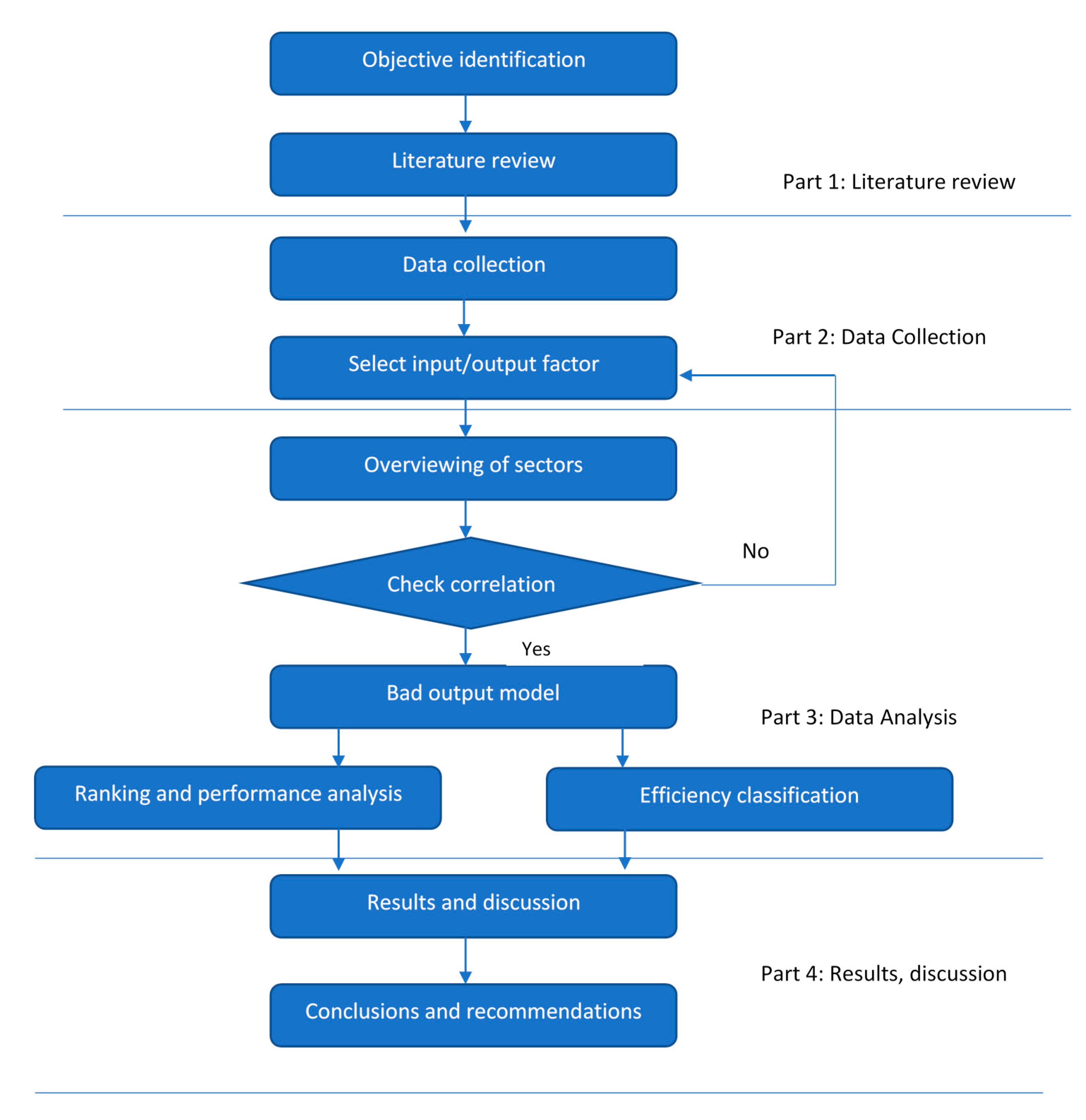
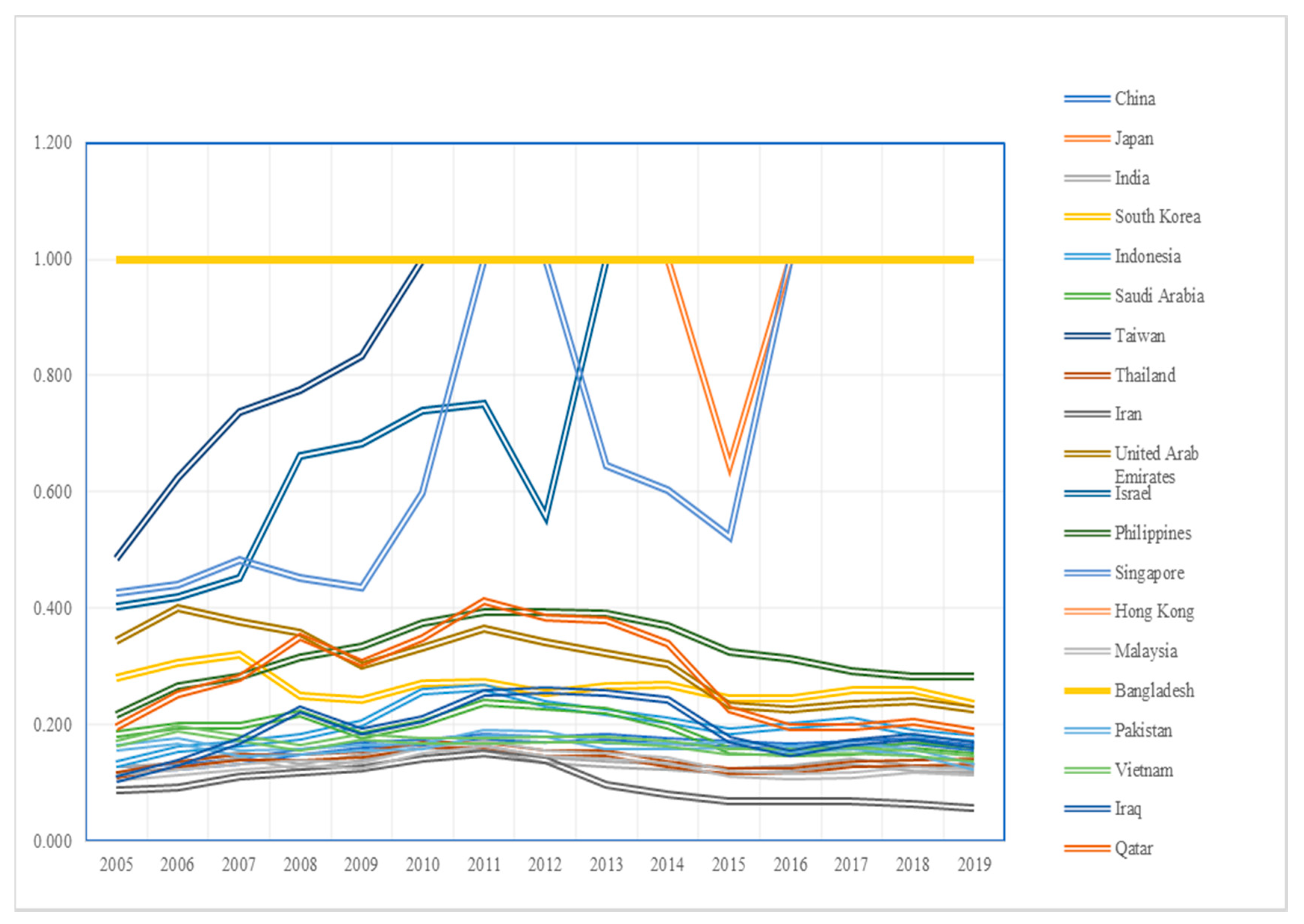
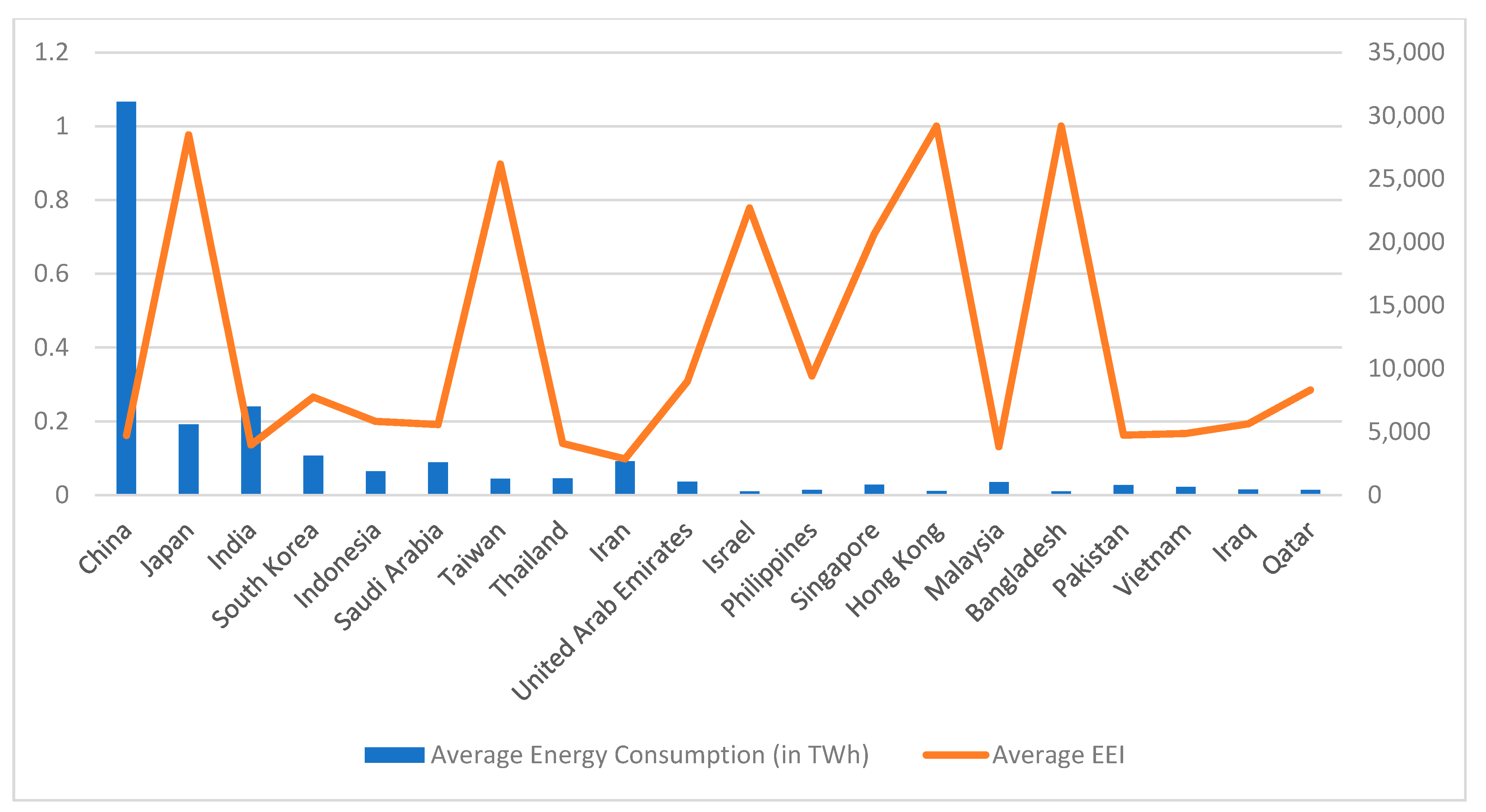


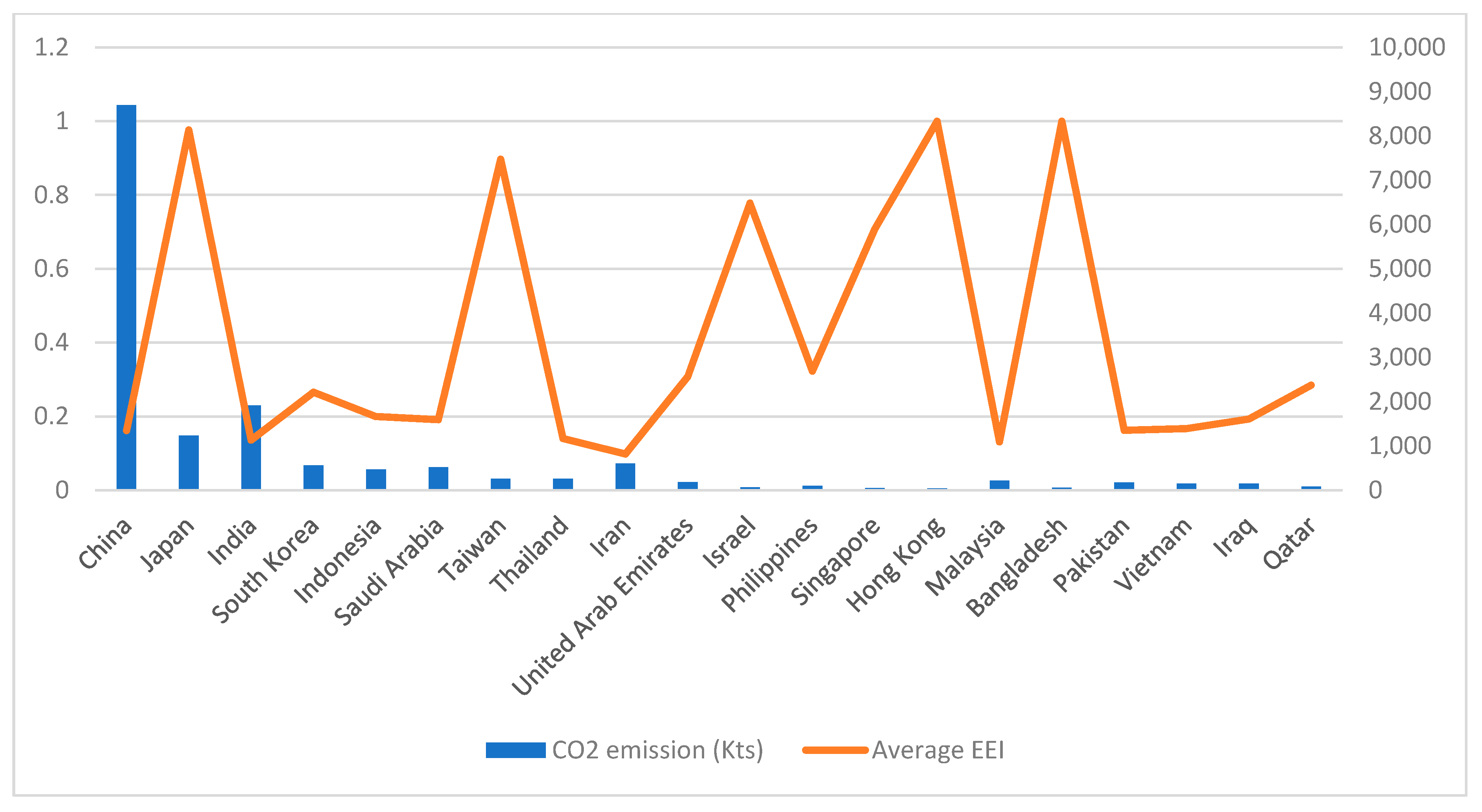
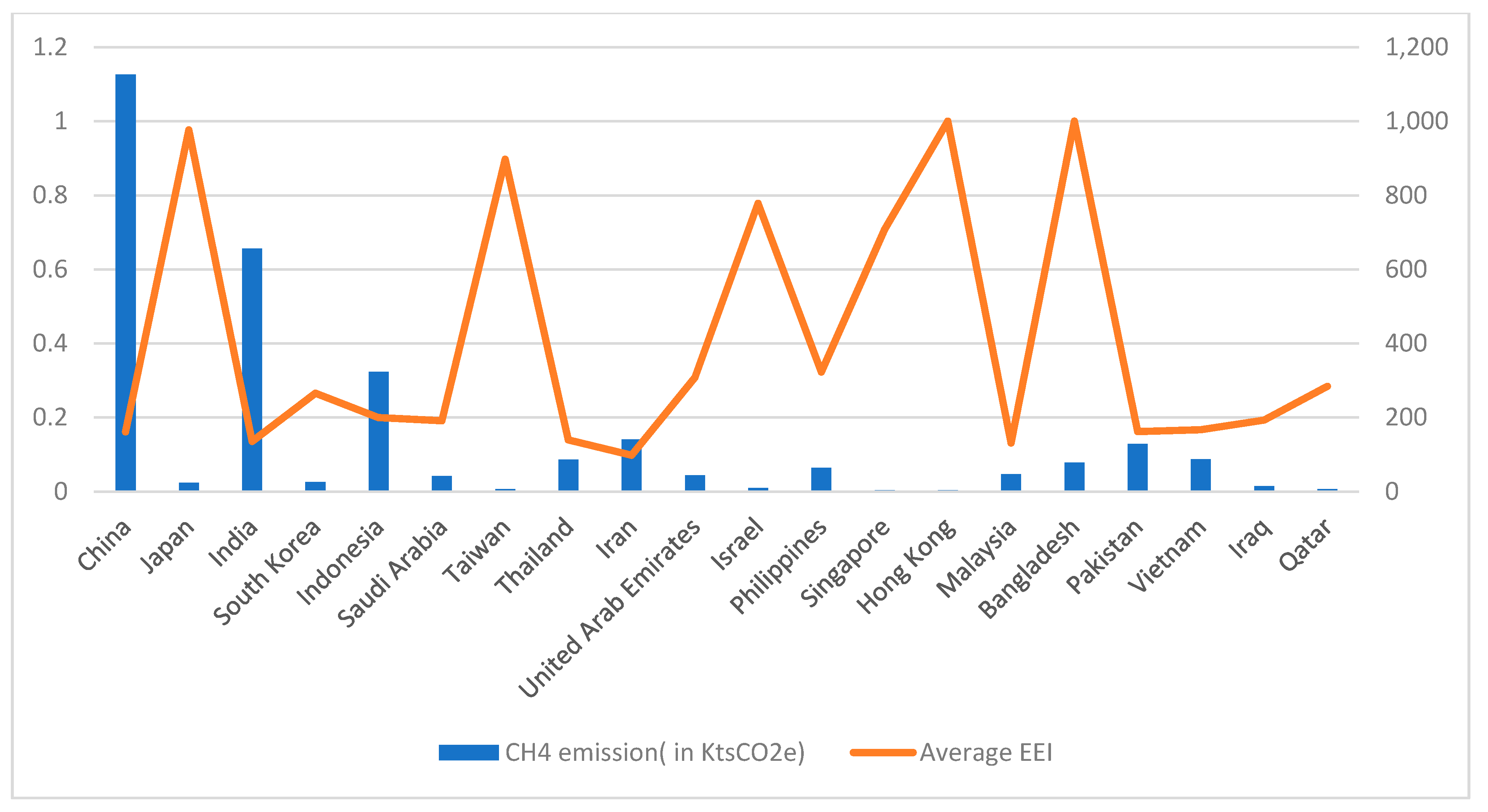
| No. | DMUs | Countries/Regions | GDP (in 2019) | No. | DMUs | Countries/Regions | GDP (in 2019) |
|---|---|---|---|---|---|---|---|
| 1 | DMU1 | China | 14343 | 11 | DMU11 | Israel | 395 |
| 2 | DMU2 | Japan | 5082 | 12 | DMU12 | Philippines | 377 |
| 3 | DMU3 | India | 2875 | 13 | DMU13 | Singapore | 372 |
| 4 | DMU4 | South Korea | 1642 | 14 | DMU14 | Hong Kong | 366 |
| 5 | DMU5 | Indonesia | 1119 | 15 | DMU15 | Malaysia | 365 |
| 6 | DMU6 | Saudi Arabia | 793 | 16 | DMU16 | Bangladesh | 303 |
| 7 | DMU7 | Taiwan | 605 | 17 | DMU17 | Pakistan | 278 |
| 8 | DMU8 | Thailand | 544 | 18 | DMU18 | Vietnam | 262 |
| 9 | DMU9 | Iran | 445 | 19 | DMU19 | Iraq | 234 |
| 10 | DMU10 | United Arab Emirates | 421 | 20 | DMU20 | Qatar | 183 |
| Inputs | Desirable Outputs | Undesirable Outputs |
|---|---|---|
| Energy consumption from coal, oil, gas sources | GDP | CO2 emission CH4 emission |
| Volume of vehicles |
| Indicator | Unity | Max | Min | Average | |
|---|---|---|---|---|---|
| Inputs | Energy consumption from coal, oil, gas sources | Terawatt-hours (TWh) | 39,360.93 | 189.63 | 3153.05 |
| Volume of Vehicles | Thousands of vehicles | 253,872 | 97 | 17,764.63 | |
| Desirable Outputs | GDP | Billions of Dollars (Bil.$) | 14,342.90 | 44.53 | 1103.84 |
| Undesirable Outputs | CO2 Emissions | Kilotons (Kts) | 10,175 | 30.27 | 789.85 |
| CH4 Emissions | Kilotons carbon dioxide equivalents (Kts CO₂e) | 1328.50 | 2.26 | 145.90 |
| Variable | Energy Consumption | Volume of Vehicles | GDP | CO2 Emissions | CH4 Emissions |
|---|---|---|---|---|---|
| Energy Consumption | 1 | 0.967 ** | 0.964 ** | 0.999 ** | 0.933 ** |
| Volume of Vehicles | 0.967 ** | 1 | 0.985 ** | 0.966 ** | 0.906 ** |
| GDP | 0.964 ** | 0.985 ** | 1 | 0.959 ** | 0.856 ** |
| CO2 Emissions | 0.999 ** | 0.966 ** | 0.959 ** | 1 | 0.944 ** |
| CH4 Emissions | 0.933 ** | 0.906 ** | 0.856 ** | 0.944 ** | 1 |
| DMU | 2005 | 2006 | 2007 | 2008 | 2009 | 2010 | 2011 | 2012 | 2013 | 2014 | 2015 | 2016 | 2017 | 2018 | 2019 | |
|---|---|---|---|---|---|---|---|---|---|---|---|---|---|---|---|---|
| China | DMU1 | 0.123 | 0.127 | 0.138 | 0.155 | 0.165 | 0.170 | 0.181 | 0.175 | 0.179 | 0.172 | 0.169 | 0.164 | 0.169 | 0.172 | 0.162 |
| Japan | DMU2 | 1 | 1 | 1 | 1 | 1 | 1 | 1 | 1 | 1 | 1 | 0.647 | 1 | 1 | 1 | 1 |
| India | DMU3 | 0.123 | 0.130 | 0.149 | 0.127 | 0.144 | 0.167 | 0.162 | 0.140 | 0.133 | 0.127 | 0.121 | 0.125 | 0.138 | 0.126 | 0.123 |
| South Korea | DMU4 | 0.281 | 0.307 | 0.321 | 0.251 | 0.243 | 0.273 | 0.275 | 0.254 | 0.267 | 0.268 | 0.246 | 0.245 | 0.260 | 0.259 | 0.236 |
| Indonesia | DMU5 | 0.132 | 0.159 | 0.167 | 0.180 | 0.202 | 0.257 | 0.265 | 0.237 | 0.222 | 0.209 | 0.190 | 0.198 | 0.208 | 0.187 | 0.178 |
| Saudi Arabia | DMU6 | 0.184 | 0.198 | 0.199 | 0.220 | 0.182 | 0.203 | 0.239 | 0.230 | 0.223 | 0.199 | 0.157 | 0.151 | 0.154 | 0.165 | 0.157 |
| Taiwan | DMU7 | 0.487 | 0.625 | 0.737 | 0.775 | 0.834 | 1 | 1 | 1 | 1 | 1 | 1 | 1 | 1 | 1 | 1 |
| Thailand | DMU8 | 0.114 | 0.132 | 0.145 | 0.145 | 0.149 | 0.166 | 0.165 | 0.151 | 0.151 | 0.132 | 0.121 | 0.122 | 0.132 | 0.135 | 0.138 |
| Iran | DMU9 | 0.087 | 0.093 | 0.111 | 0.118 | 0.125 | 0.141 | 0.151 | 0.139 | 0.097 | 0.081 | 0.069 | 0.070 | 0.070 | 0.064 | 0.056 |
| United Arab Emirates | DMU10 | 0.345 | 0.402 | 0.377 | 0.359 | 0.302 | 0.333 | 0.366 | 0.342 | 0.324 | 0.305 | 0.235 | 0.228 | 0.236 | 0.240 | 0.228 |
| Israel | DMU11 | 0.403 | 0.421 | 0.454 | 0.662 | 0.683 | 0.741 | 0.751 | 0.558 | 1 | 1 | 1 | 1 | 1 | 1 | 1 |
| Philippines | DMU12 | 0.218 | 0.266 | 0.283 | 0.316 | 0.334 | 0.374 | 0.394 | 0.393 | 0.391 | 0.371 | 0.326 | 0.313 | 0.292 | 0.284 | 0.284 |
| Singapore | DMU13 | 0.428 | 0.440 | 0.482 | 0.453 | 0.436 | 0.599 | 1 | 1 | 0.645 | 0.603 | 0.524 | 1 | 1 | 1 | 1 |
| Hong Kong | DMU14 | 1 | 1 | 1 | 1 | 1 | 1 | 1 | 1 | 1 | 1 | 1 | 1 | 1 | 1 | 1 |
| Malaysia | DMU15 | 0.110 | 0.118 | 0.128 | 0.134 | 0.131 | 0.157 | 0.168 | 0.152 | 0.146 | 0.139 | 0.117 | 0.111 | 0.115 | 0.124 | 0.118 |
| Bangladesh | DMU16 | 1 | 1 | 1 | 1 | 1 | 1 | 1 | 1 | 1 | 1 | 1 | 1 | 1 | 1 | 1 |
| Pakistan | DMU17 | 0.161 | 0.172 | 0.151 | 0.154 | 0.162 | 0.164 | 0.186 | 0.185 | 0.164 | 0.164 | 0.166 | 0.157 | 0.162 | 0.154 | 0.128 |
| Vietnam | DMU18 | 0.167 | 0.195 | 0.176 | 0.162 | 0.181 | 0.173 | 0.173 | 0.175 | 0.176 | 0.167 | 0.153 | 0.154 | 0.155 | 0.151 | 0.142 |
| Iraq | DMU19 | 0.106 | 0.134 | 0.172 | 0.227 | 0.190 | 0.211 | 0.254 | 0.260 | 0.256 | 0.243 | 0.174 | 0.152 | 0.171 | 0.180 | 0.166 |
| Qatar | DMU20 | 0.197 | 0.252 | 0.280 | 0.353 | 0.306 | 0.348 | 0.413 | 0.385 | 0.379 | 0.340 | 0.226 | 0.197 | 0.197 | 0.207 | 0.189 |
| Hong Kong | DMU14 | 1 |
| Bangladesh | DMU16 | 1 |
| Japan | DMU2 | 0.97646 |
| Taiwan | DMU7 | 0.89709 |
| Israel | DMU11 | 0.77821 |
| Singapore | DMU13 | 0.70733 |
| Philippines | DMU12 | 0.32261 |
| United Arab Emirates | DMU10 | 0.30803 |
| Qatar | DMU20 | 0.28455 |
| South Korea | DMU4 | 0.26572 |
| Indonesia | DMU5 | 0.19943 |
| Iraq | DMU19 | 0.19291 |
| Saudi Arabia | DMU6 | 0.19082 |
| Vietnam | DMU18 | 0.16659 |
| Pakistan | DMU17 | 0.16197 |
| China | DMU1 | 0.16142 |
| Thailand | DMU8 | 0.13976 |
| India | DMU3 | 0.13565 |
| Malaysia | DMU15 | 0.13101 |
| Iran | DMU9 | 0.09813 |
| Correlations | |||||||
|---|---|---|---|---|---|---|---|
| EEI | Energy Consumption | Volume of Vehicles | GDP | CO2 Emission | CH4 Emission | ||
| EEI | Pearson Correlation | 1 | −0.180 ** | −0.062 | 0.031 | −0.188 ** | −0.326 ** |
| (I) Energy Consumption | (I) Volume Vehicles | (O) CO2 | (O) CH4 | (O) GDP | |||||||
|---|---|---|---|---|---|---|---|---|---|---|---|
| DMU | Score | Projection | Change (%) | Projection | Change (%) | Projection | Change (%) | Projection | Change (%) | Projection | Change (%) |
| DMU1 | 0.14 | 5101.00 | −0.80 | 8724.96 | −0.80 | 731.09 | −0.89 | 48.99 | −0.95 | 3550.34 | 0.00 |
| DMU2 | 1.00 | 6126.68 | 0.00 | 75,715.00 | 0.00 | 1302.52 | 0.00 | 26.42 | 0.00 | 4515.26 | 0.00 |
| DMU3 | 0.15 | 1748.16 | −0.67 | 2990.12 | −0.90 | 250.55 | −0.82 | 16.79 | −0.97 | 1216.74 | 0.00 |
| DMU4 | 0.32 | 1684.77 | −0.39 | 2881.70 | −0.82 | 241.47 | −0.51 | 16.18 | −0.38 | 1172.61 | 0.00 |
| DMU5 | 0.17 | 620.99 | −0.60 | 1062.17 | −0.92 | 89.00 | −0.76 | 5.96 | −0.98 | 432.22 | 0.00 |
| DMU6 | 0.20 | 597.64 | −0.70 | 1022.23 | −0.74 | 85.66 | −0.78 | 5.74 | −0.86 | 415.96 | 0.00 |
| DMU7 | 0.74 | 1108.48 | −0.16 | 5088.33 | −0.24 | 179.64 | −0.34 | 9.06 | 0.00 | 783.80 | 0.00 |
| DMU8 | 0.15 | 377.79 | −0.65 | 646.18 | −0.93 | 54.15 | −0.77 | 3.63 | −0.96 | 262.94 | 0.00 |
| DMU9 | 0.11 | 502.70 | −0.78 | 859.83 | −0.90 | 72.05 | −0.86 | 4.83 | −0.96 | 349.88 | 0.00 |
| DMU10 | 0.38 | 370.56 | −0.55 | 633.83 | −0.41 | 53.11 | −0.60 | 3.56 | −0.90 | 257.92 | 0.00 |
| DMU11 | 0.45 | 257.12 | −0.04 | 439.79 | −0.80 | 36.85 | −0.41 | 2.47 | −0.69 | 178.96 | 0.00 |
| DMU12 | 0.28 | 224.11 | −0.29 | 383.32 | −0.93 | 32.12 | −0.55 | 2.15 | −0.97 | 155.98 | 0.00 |
| DMU13 | 0.48 | 259.97 | −0.60 | 444.66 | −0.37 | 37.26 | −0.22 | 2.50 | −0.04 | 180.94 | 0.00 |
| DMU14 | 1.00 | 304.02 | 0.00 | 520.00 | 0.00 | 43.57 | 0.00 | 2.92 | 0.00 | 211.60 | 0.00 |
| DMU15 | 0.13 | 278.08 | −0.69 | 475.64 | −0.94 | 39.86 | −0.78 | 2.67 | −0.94 | 193.55 | 0.00 |
| DMU16 | 1.00 | 210.29 | 0.00 | 122.00 | 0.00 | 42.64 | 0.00 | 74.17 | 0.00 | 79.61 | 0.00 |
| DMU17 | 0.15 | 218.94 | −0.70 | 374.49 | −0.87 | 31.38 | −0.80 | 2.10 | −0.98 | 152.39 | 0.00 |
| DMU18 | 0.18 | 111.23 | −0.69 | 190.25 | −0.79 | 15.94 | −0.84 | 1.07 | −0.99 | 77.41 | 0.00 |
| DMU19 | 0.17 | 127.64 | −0.61 | 218.32 | −0.91 | 18.29 | −0.70 | 1.23 | −0.90 | 88.84 | 0.00 |
| DMU20 | 0.28 | 114.53 | −0.56 | 195.89 | −0.68 | 16.41 | −0.74 | 1.10 | −0.74 | 79.71 | 0.00 |
Publisher’s Note: MDPI stays neutral with regard to jurisdictional claims in published maps and institutional affiliations. |
© 2021 by the authors. Licensee MDPI, Basel, Switzerland. This article is an open access article distributed under the terms and conditions of the Creative Commons Attribution (CC BY) license (https://creativecommons.org/licenses/by/4.0/).
Share and Cite
Wang, C.-N.; Nguyen, H.-P.; Chang, C.-W. Environmental Efficiency Evaluation in the Top Asian Economies: An Application of DEA. Mathematics 2021, 9, 889. https://doi.org/10.3390/math9080889
Wang C-N, Nguyen H-P, Chang C-W. Environmental Efficiency Evaluation in the Top Asian Economies: An Application of DEA. Mathematics. 2021; 9(8):889. https://doi.org/10.3390/math9080889
Chicago/Turabian StyleWang, Chia-Nan, Hoang-Phu Nguyen, and Cheng-Wen Chang. 2021. "Environmental Efficiency Evaluation in the Top Asian Economies: An Application of DEA" Mathematics 9, no. 8: 889. https://doi.org/10.3390/math9080889
APA StyleWang, C.-N., Nguyen, H.-P., & Chang, C.-W. (2021). Environmental Efficiency Evaluation in the Top Asian Economies: An Application of DEA. Mathematics, 9(8), 889. https://doi.org/10.3390/math9080889








